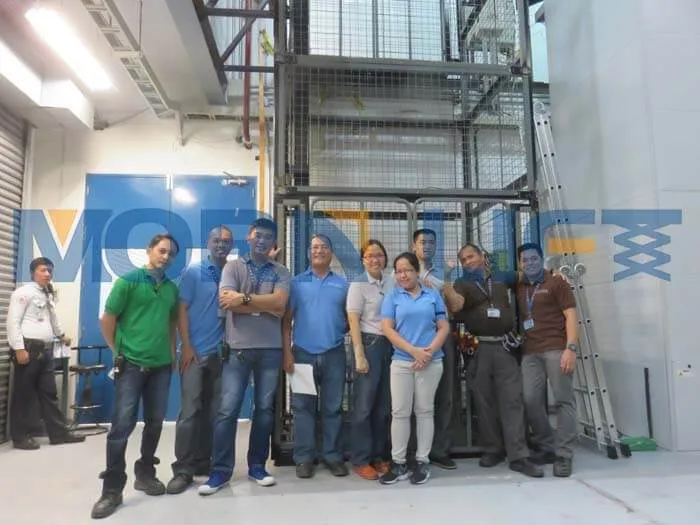Table of Contents
The Structure Composition principle and performance analysis of hydraulic freight lifts
The hydraulic freight lifts is an indispensable equipment in the current society. The lift can be seen everywhere. The main feature of the freight lift is the large load-bearing capacity, which makes up for the shortcomings of the general elevator.
As the name suggests, hydraulic freight lifts are driven by hydraulic system. Guide rail and chain lifting platforms (lifting freight elevators) are a large-tonnage load equipment that uses hydraulic lifting methods commonly seen in real life. It has a wide range of applications, such as production workshops, three-dimensional garages, and family villas. For private use, it is simple and convenient to operate. It is a kind of hydraulic freight lifts with great demand.


Lift System
Hydraulic pressure refers to the power source and transmission method of the freight lifts during the lifting process. Of course, hydraulic transmission is inseparable from the most important part-the hydraulic cylinder.
Hydraulic cylinder
The hydraulic system is an important part of the hydraulic lift. The hydraulic cylinder is the actuator in the hydraulic system; it is generally composed of a cylinder, a cylinder rod (piston rod) and a seal. The inside of the cylinder is divided into two parts by a piston, each passing through one oil hole. Because the compression ratio of the liquid is very small, when one of the oil holes enters oil, the piston will be pushed to make the other oil hole discharge oil, and the piston drives the piston rod to extend (retract), and vice versa.
The hydraulic cylinders used in hydraulic elevators usually have the following five parts: 1. cylinder and cylinder head 2. piston and piston rod 3. sealing device 4. buffer device 5. exhaust device. The working principle is basically similar to that of ordinary hydraulic cylinders. Take a manual jack for example. The jack is actually the simplest cylinder. Manually pressurize the stalk (hydraulic manual pump) to make the hydraulic oil enter the cylinder through a one-way valve. At this time, the hydraulic oil entering the cylinder cannot be reversed because of the single valve, forcing the cylinder rod upward, and then continuing to use the hydraulic oil during work. Continue to enter the hydraulic cylinder and continue to rise like this. When you want to fall, open the hydraulic valve to make the hydraulic oil return to the tank. This is the simplest working principle. The others are improved on this basis. The cylinder and the oil cylinder The principle is basically the same.
The hydraulic cylinder is the most important part of the hydraulic freight lifts, but the hydraulic cylinder is not very important in the maintenance of the entire equipment, because the structure and material of the hydraulic cylinder are determined by its high load-bearing capacity, simple structure and not easy to damage.
Chain and hydraulic oil
We should pay more attention to the use of chains and hydraulic oil for freight lifts, which are also a measure of the quality of a piece of equipment.
In fact, there are two types of chains commonly used in hydraulic rail-type elevators. They are selected according to the size of the table and the load capacity. They are national standard LH1034 and LH1644 high-strength chains. Customers need to pay attention when signing contracts with manufacturers. For the configuration of the freight elevator, if you can choose 20A, use a 20A chain. In addition, for hydraulic oil, due to the existence of many hydraulic oil brand products in China, the quality is also uneven. Many manufacturers use inferior hydraulic oil when they leave the factory, which has a great impact on the use of hydraulic equipment. If the contract specifies the production If the manufacturer provides hydraulic oil, the brand of hydraulic oil should be indicated. All of our company’s hydraulic lifting equipment adopts the Great Wall brand high-performance hydraulic oil produced by Sinopec, which is conducive to the use of products and can also improve the efficiency of the equipment.
Seal ring
The seal is also a very important part of the hydraulic freight lifts.
Seals are materials or parts that prevent fluid or solid particles from leaking between adjacent joint surfaces and prevent foreign impurities such as dust and moisture from intruding into parts of machinery and equipment. The performance factors of various seals are different, such as mechanical seals (packing seals, etc.) affecting factors such as temperature, medium, wear, and pressure. According to different purposes, seals are roughly classified as follows: 1. Classification by function: divided into shaft seal, hole seal, dust seal, guide ring, fixed seal, and rotary seal; 2. Classification by material: For rubber, polyurethane, engineering plastics, etc.
Although the seal is small, it plays a great role in the hydraulic lift. Whether the seals in the elevator are qualified and whether they are placed in accordance with the regulations during installation are closely related to the normal use of the elevator. Sometimes a simple improper use of a sealing ring may be the culprit that affects your elevator’s oil leakage and malfunction!
How to Identify the Quality of the Lift?
There is a simple way to distinguish the quality of the hydraulic freight lifts, that is, “the heavier the elevator, the better the quality” and the main materials that constitute the elevator are various types of steel. There are many different types of steel used in hydraulic elevators, and With the specific functions of the equipment, the models used are also different in size. From the perspective of domestic lifting equipment manufacturers, the use of steel often determines the overall quality of a piece of equipment.
At present, the steel of all specifications and types with the greatest pressure and strength is the H beam, which is generally used in relatively large hydraulic lifting equipment. The H beam is rarely used for the low load and lifting requirements, and the rectangular tube is often used as the The main material, customers need to pay attention to the specific dimensions of the rectangular tube (especially the wall thickness of the rectangular tube) and other details when choosing the lifting equipment. Many domestic companies often use non-standard in order to save costs when producing equipment. Rectangular tubes are produced, which causes the weight of the entire equipment to be relatively small, which greatly affects the practicability of the equipment.
For large-scale equipment, the country has clear requirements to use standard or even ultra-high standard steel for production, and companies without corresponding production qualifications are banned. Therefore, when customers choose large and medium-sized hydraulic lifting equipment, they must choose complete qualifications and have strong production capabilities. Of companies to cooperate in order to avoid serious economic losses caused by various problems in the future.





